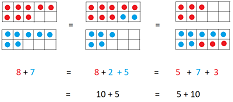First grade math concepts or curriculum
Find here many important first grade math concepts taught in first grade. Teachers, parents, and math tutors can also use them as a guideline to illustrate a math lesson or to teach important skills that kids are supposed to know in first grade math.
Equal parts or equal shares
The orange circle has 2 equal parts
The blue circle has 4 equal parts

Arrays
An array is an arrangement of objects in equal rows or columns.
The first array is made of soccer balls
The array has 2 rows and 3 columns
2 × 3 = 6 balls
The second array is made of squares.The array has 3 rows and 4 columns
3 × 4 = 12 squares

Quarter
Quarter = one-fourth = 1 of 4 equal parts. The square below is divided into 4 equal pieces. One piece shown in green is a quarter or one-fourth.

Associative property
2 + 3 + 1 = (2 + 3) + 1
= 2 + (3 + 1)
= 6

Closed figure
All sides of a closed figure are connected. If there is any gap or opening no matter how small, then it is not a closed figure.

Hour hand
The hour hand takes 1 hour to move from a number to the next. The hour hand is smaller.
Hour or hr = 60 minutes

Estimate
An estimate is not the same as an exact answer. We just need a number close to the exact amount. To estimate the number of marbles, we just need to know about how many
Possible answers: 15, 14, or 17

Commutative property
Whether 2 is written first or not, the answer to 2 + 1 is still 3
2 + 1 = 1 + 2 = 3

2-dimensional figures
Examples of two-dimensional figures are pentagons, triangles, rectangles, and circles.

Types of clocks
Two types of clocks are analog clocks and digital clocks. An analog clock uses two or three hands to show the time. A digital clock uses numbers to show the time.

Cube
A cube has 6 faces, 12 edges and 8 vertices. The cube below shows 3 faces with the color red, blue, and orange. The cube also shows a vertex with a tiny white circle.

Multiples of 10
The multiples of 10 are 10, 20, 30, 40, 50, 60, ...
Counting up
Start at 3 and count 2 more to reach 5

More important first grade math concepts
Number
A number indicates how many or how much. A numeral is used to represent the number of objects. For example, after counting the pencils in the figure below, we get 4. We use the numeral 4 to represent 4 pencils.

3-dimensional shapes
3 dimensional shapes are solid shapes that have width, length, and height.
Examples of three-dimensional shapes are cones, cylinders, soda cans, soccer balls, and spheres.

Make 10
Make 10 is a strategy that can help kids to quickly add two numbers.
For example, to quickly add 8 and 7, kids can try to make a ten first.
8 + 7 = (8 + 2) + 5 = 10 + 5 = 15
8 + 7 = 5 + (3 + 7) = 5 + 10 = 15

Minute hand
The minute hand takes 5 minutes to move from a number to the next. The minute hand is bigger.
1 minute = 60 seconds
5 minutes = 300 seconds

Different
The two triangles are different, but they have the same shape.

Counting down
Start at 6 and count backward to reach 2.

Composite shape
The arrow shown below is a composite shape since it is made from 2 basic shapes (a triangle and a rectangle)
Collecting data

Expression
An expression has no equal sign. For example, 8 + 4 - 6 is an expression.

Coins
A coin is a flat and round piece of metal that is used as money in a country.
In United States, the coins that are mostly used are pennies, nickels, dimes, and quarters.
1 penny = 1 cent
1 nickel = 5 cents
1 dime = 10 cents
1 quarter = 25 cents
2 dimes + 1 quarter + 3 nickels = 60 cents

Equation
Equation always have an equal sign. The amount on the left side is equal to the amount on the right side. For example, 2 + 4 = 6 is an equation.

Things to keep in mind about the first grade math concepts on this page
1. Make sure that students understand most of the math skills above taught in first grade math. If you would like to measure their understanding of math skills taught in first grade math, please check this first grade math test.
2. These first grade math concepts are in line with first grade math common core state standards.